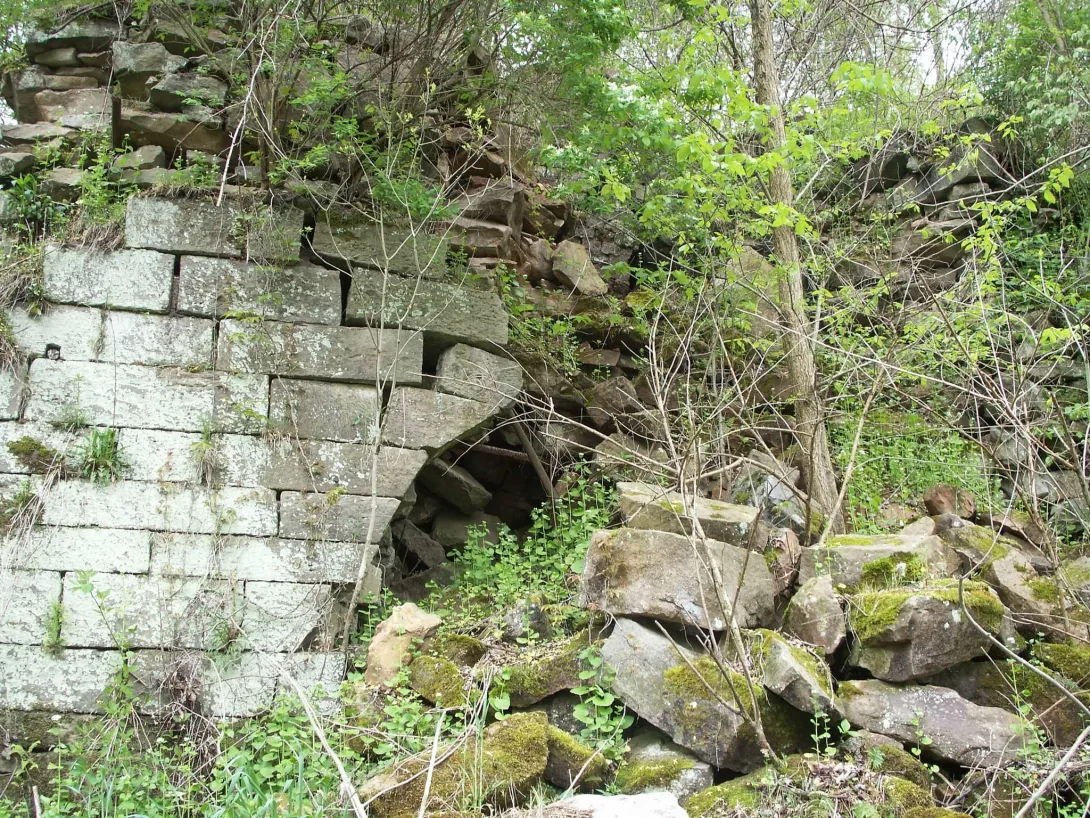The 150-year-old furnaces, built of stone, are located along State Highway Route 68, about one mile upstream from the point where Sugar Creek empties into the Allegheny River, on the north side of the river bridge at East Brady. The rolling mill was located on the west bank of the Allegheny River below the mouth of Sugar Creek. This mill once made Bradys Bend one of the world's leading iron centers. The furnaces were of the hot-blast type, powered by a 250-horsepower steam engine. This engine was also used to power the refining fires. A 250 H.P. engine also powered the mill. One furnace was built and first "blown in" around Christmas in 1840. The rolling mill went into production in January 1842, and a short time later, a railroad was built connecting the furnace and the rolling mill.
Facts and data are available concerning these old furnaces, and the rolling mill, once a nucleus of industrial development, show why Bradys Bend, called by some the "Pittsburgh of the Middle 1800," is justified in laying a claim to the little "Cradle of the Iron and Steel Industry in America."
These furnaces were once considered for purchase by Henry Ford, who was interested in using them in his industrial museum in Dearborn, Michigan. Far-sighted local school board members visualized the growth of interest in this historic site when they purchased property adjoining the two-acre section of land on which the furnaces are located for an elementary school building in 1953 from Mr. Edward R. Dewey of the Dewey Trust Estate. Mr. Dewey graciously donated the two acres of land on which the furnaces stand and had a clause written into the deed stating that the historic furnaces must not be destroyed.
The merchant mill was erected to manufacture iron nails and merchant iron. Several machines designed for this purpose were manufactured, but upon trial, the iron was found not to be suitable for this branch of manufacture. The manufacture of strap iron rails commenced and continued until the Great Western Iron Company was dissolved in 1843.
The Bradys Bend Iron Company acquired possession of the company and its property in 1844, erecting a second blast furnace in 1845 and continuing the manufacture of strap iron rails until 1846. In the latter part of 1846, the Works were altered to manufacture T-rails. The company was credited with manufacturing the first Trails West of the Alleghenies. It was in prosperous operation until 1858, when, owing to the death of the principal proprietor, it was shut down until 1863.
A new organization was established in the fall of 1862, and work began in all departments in February 1863. It continued uninterrupted until October 1873. During this time, the company became the state's leading iron manufacturing center. The Pennsylvania Railroad and the Illinois Central were the company's largest customers.In October 1873, when the financial crash swept the country, these works succumbed to the pressure.
Among those who occupied responsible positions for over twenty-five years was Mr. Alexander Campbell, whose hand guided the first T-rail rolled west of the Allegheny Mountains and who, thirty years after this achievement, assisted at the Edgar Thompson Steel Mill in rolling the enormous 120-foot-long steel rail exhibited at the Centennial Exposition.
After closing in 1873, the Works lay idle until 1879. At this time, it was dismantled and sold for scrap for $5,000. The buildings were left to decay. Again, in 1894, another company was formed, calling itself the Bradys Bend Coal and Iron Company. The men behind this venture borrowed $350,000 from a New York bank to develop the oil resources. However, these men squandered the money, and the bank took control of the property.In 1901, Mr. Edward W. Dewey, a descendant of the late Admiral Dewey, bought the property that the Bradys Bend Iron Company had previously owned for $40,000. After Mr. Dewey's retirement and subsequent death, his son, Mr. Edward R. Dewey, managed the property from 1916 to 1968.
Sections of the acreage were developed for real estate. Oil and gas leases were granted. Thirteen hundred acres went to the state for a game reserve. The Edward R. Dewey Estate is presently the most significant single landowner in Bradys Bend Township, with 2500 acres remaining of the 6,400 acres formerly owned by the Bradys Bend Iron Company.
Mr. Edward R. Dewey gave the Historical Society of Western Pennsylvania a hundred-year-old, extensively detailed record of the Bradys Bend Iron Company. This collection, which includes numerous old documents, traces the 140-year history of industrial development in the Bradys Bend community.From a small beginning, Bradys Bend's iron and steel industry grew to be a blessing to the surrounding country, employing 1200 to 1500 men and supporting a population of about 5,000 people. The sector benefited not only Armstrong County but also Clarion and Butler Counties. The coal output for these Works rose to 110,000 tons per year, and the annual production of ore rose to 70,000 tons. The product was shipped to all parts of the country, returning millions of dollars to enrich the community.
In October 1872, in a report to the Bradys Bend Iron Company from W. Bailey Lang and Company, the company's assets were set at $7,575,900. The company then held 5,359 acres and leased 855 acres. The property contained iron ore and coal mines, limestone quarries, fire clay deposits, coke ovens, blast furnaces, calcining yards, rolling mill, machine shops, brickworks, petroleum wells, locomotive railways, tramways, manager and workmen houses, offices, stables, hotel and other buildings needed for the various activities. Approximately 1,000 acres of farmland were leased to farmers to produce food for the laborers.
From a dense wilderness, a town built by the company for its employees sprang up. The town consisted of about 700 houses, eleven churches of various denominations, two elementary schools ranking among the best in the country, and stores and warehouses. The neighboring town of East Brady owes its existence to the Iron Works.Return to
